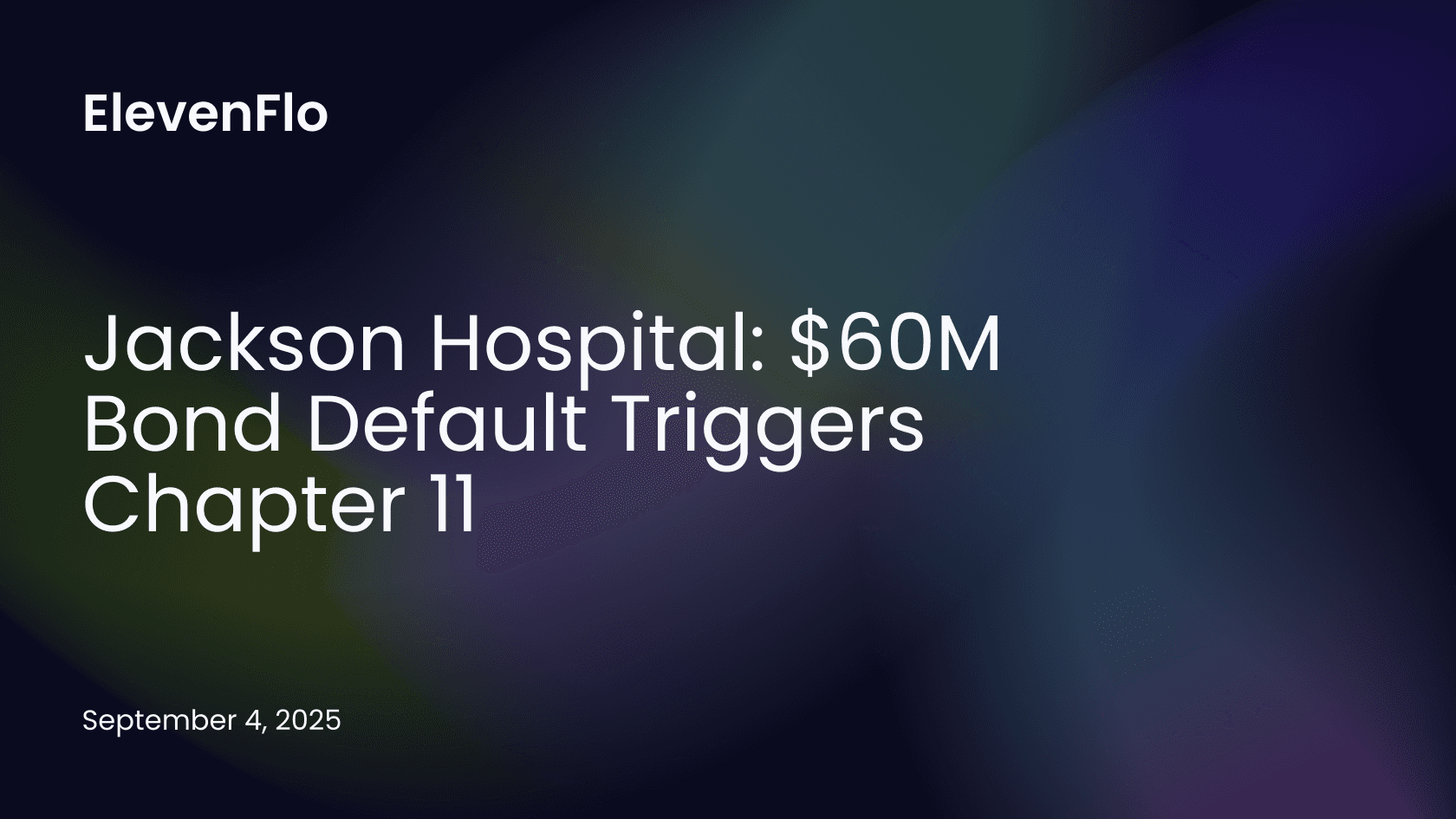Higher Ground Education Montessori Collapse

Higher Ground Education files Chapter 11 after collapsing from 150+ Montessori schools to just 7 operational facilities
Higher Ground Education, Inc. and 33 affiliated entities filed for Chapter 11 bankruptcy protection on June 17, 2025, in the United States Bankruptcy Court for the Northern District of Texas. The filing, under case number 25-80121-11 (MVL), represents the dramatic collapse of what was once the world's largest owner and operator of Montessori schools, with total funded debt of $144 million according to Law360.
The Higher Ground Education bankruptcy follows a catastrophic operational failure that saw the company shrink from over 150 schools to just seven operational facilities at the petition date. According to Chapter 11 Cases, the company raised over $335 million since 2020 but accumulated operating losses exceeding $440 million in five years and never achieved positive cash flow.
Corporate History and Ambitious Expansion
Founded in 2016 by educators and business leaders, Higher Ground Education aimed to modernize and mainstream Montessori education. The company operated schools under the Guidepost Montessori brand for early childhood education and Guidepost Academy for elementary and middle school students. Co-founders Ramandeep (Ray) Girn and Rebecca Girn led the company's aggressive expansion strategy.
The company's growth trajectory appeared remarkable on paper. From 12 schools in 2018, Higher Ground Education expanded to 27 schools in 2019, 60 schools in 2020, and ultimately reached 150 schools by 2024. This expansion spanned multiple states including Texas, North Carolina, California, New York, Illinois, Florida, and Virginia, with additional international operations in China and Hong Kong.
Venture Capital Funding and Technology Strategy
In January 2021, Higher Ground Education secured a $40 million Series C funding round led by Venn Growth Partners, as reported by EdSurge. At that time, the company had raised $70 million total in venture capital, operated 80 schools across the U.S. and China serving approximately 7,000 students, and aimed to open 40 new schools annually.
The company acquired Altitude Learning’s learning management system in 2021 (not 2020), believing it could revolutionize Montessori classroom operations across its network.
Financial Deterioration and Operational Collapse
Despite raising substantial venture capital, the Higher Ground Education bankruptcy reveals a company that never achieved sustainable operations. According to court filings detailed by Chapter 11 Cases, the company lost over $440 million during its operational history and never generated positive cash flow. According to CBS Colorado, individual schools were running losses of $50,000+ per month that creditors would no longer subsidize.
The financial crisis accelerated in early 2025 when co-founders Ray and Rebecca Girn resigned on February 25, 2025. Their departure triggered a cascade of creditor actions, including multiple foreclosures that eliminated the vast majority of the company's operational schools between March and April 2025.
Mass School Closures and Family Impact
The collapse had devastating impacts on families across the country. According to The 74 Million, the company closed at least 16 locations across states including Colorado, Ohio, Iowa, Minnesota, Missouri, Oklahoma, Virginia, and Wisconsin. Co-CEO Maris Mendes acknowledged they were closing nearly one-third of the school communities built over nine years.
In Colorado alone, five Guidepost Montessori schools announced sudden closures affecting approximately 300 families, as reported by CBS Colorado. Parents received closure notices via email with as little as two weeks' notice, forcing them to scramble for alternative childcare and educational arrangements. Many families had prepaid tuition and enrollment fees that were never refunded.
Complex Debt Structure and Creditor Foreclosures
The Higher Ground Education bankruptcy filing reveals a complex debt structure totaling $144.2 million in funded debt obligations. According to Chapter 11 Cases, the company's financial obligations reflect its aggressive use of multiple financing sources to fund expansion.
- CN Notes: $117.8 million in convertible notes issued under a Note Purchase Agreement, with Learn Capital entities holding majority positions
- Bridge CN-3 Notes: $4.8 million in secured bridge financing obtained in early 2025
- WTI Loan Agreements: $4.7 million remaining after partial foreclosures by Venture Lending & Leasing IX and WTI Fund X
- Secured Funded Debt: Total of $127.3 million in secured obligations
- Unsecured Funded Debt: $16.9 million in various unsecured obligations
WTI Foreclosure and Asset Sales
On March 22, 2025, WTI foreclosed on certain collateral and, via a private sale, sold those assets to Guidepost Global Education, Inc. for approximately $23.08 million, including substantially all intellectual property and other assets needed to operate the schools, as detailed in the Debtors’ Disclosure Statement.
EB-5 Investor Program Complications
Higher Ground Education utilized the EB-5 immigrant investor program to fund school development, raising capital from foreign investors seeking US permanent residency. The bankruptcy jeopardizes these investors' immigration status and their financial investments, creating additional complexity in the restructuring process.
Multiple school subsidiaries were structured with EB-5 investors holding minority interests, and from 2017 to the petition date the Debtors raised approximately $50 million through the EB-5 program. The Plan contemplates transferring certain EB-5 entities to Guidepost Global as part of the restructuring. See the Debtors’ Disclosure Statement.
Pre-Arranged Restructuring Plan
The Higher Ground Education bankruptcy proceeds with a pre-arranged restructuring plan supported by key stakeholders. According to Bloomberg Law, the company requested court approval for a restructuring support agreement that includes $8 million to fund the bankruptcy case, asset transfers, and treatment of creditor claims.
The restructuring plan involves 2HR Learning, Inc. as Plan Sponsor, YYYYY, LLC as Senior DIP Lender, and Guidepost Global Education, Inc. as Junior DIP Lender, among other stakeholders. The plan contemplates confirmation by September 3, 2025, with Judge Michelle V. Larson presiding over the case. See the Debtors’ Disclosure Statement.
Remaining Operations and Future Plans
Of the original 150+ schools, only seven remain operational under debtor control at the petition date. These surviving schools will form the core of any reorganized entity, though their long-term viability remains uncertain given the company's historical inability to achieve profitability even at much larger scale.
Management Changes and Governance Crisis
The resignation of co-founders Ray and Rebecca Girn in February 2025 precipitated the final crisis. Jonathan McCarthy, a board member and managing partner of Venn Growth Partners (an equity and debt holder), was appointed Interim President and Secretary by the independent board member, Marc D. Kirshbaum.
The management transition occurred amid the company's aggressive hyper-scaling growth strategy that overextended the company financially. According to The 74 Million, the closures stemmed from this unsustainable expansion model that prioritized rapid growth over operational sustainability.
Industry Context and Educational Impact
The Higher Ground Education bankruptcy reflects broader challenges in the private education sector. The post-COVID environment has proven particularly challenging for private schools despite initial enrollment growth. Financial difficulties represent the primary reason for school closures across the industry.
The collapse raises questions about the viability of venture capital-backed education models. The pressure to achieve rapid growth and returns often conflicts with the patient, relationship-based approach required for successful educational institutions. Higher Ground Education's attempt to industrialize Montessori education through technology and standardization ultimately failed to generate sustainable operations.
Impact on Montessori Education Movement
As the world's largest Montessori operator, Higher Ground Education's failure sends shockwaves through the Montessori community. The company's stated mission to modernize and mainstream Montessori education now appears to have damaged the movement's reputation through association with financial mismanagement and sudden closures.
Legal Proceedings and Creditor Rights
The bankruptcy proceedings involve complex intercreditor issues given the multiple layers of secured and unsecured debt. Despite secured debt exceeding $127 million, the restructuring plan anticipates some recovery for unsecured creditors, unusual in cases with such significant secured obligations. This suggests either substantial asset value remains or that secured creditors are accepting reduced recoveries to facilitate a consensual plan.
Supporting parties in the restructuring include the Montessori network, Guidepost Global Education Inc., and various creditor groups. The pre-arranged nature of the plan suggests broad stakeholder consensus on the path forward.
For comprehensive analysis of education sector bankruptcies and restructuring trends, visit ElevenFlo's bankruptcy blog. The Higher Ground Education bankruptcy case continues to develop, with significant implications for venture-backed education companies and the families they serve.
Lessons and Implications
The Higher Ground Education bankruptcy serves as a cautionary tale about the risks of applying Silicon Valley growth models to education. The company's failure despite raising substantial venture capital demonstrates that capital alone cannot overcome fundamental operational challenges in education delivery. The case highlights the tension between venture capital expectations for rapid scaling and the inherently local, relationship-based nature of early childhood education.
For the thousands of families affected by school closures, the bankruptcy represents not just financial loss but disruption to their children's education and development. The sudden closures, often with minimal notice, underscore the vulnerability of families dependent on venture-backed educational institutions. As the bankruptcy proceeds toward its planned September 2025 conclusion, the future of Montessori education at scale remains uncertain.


